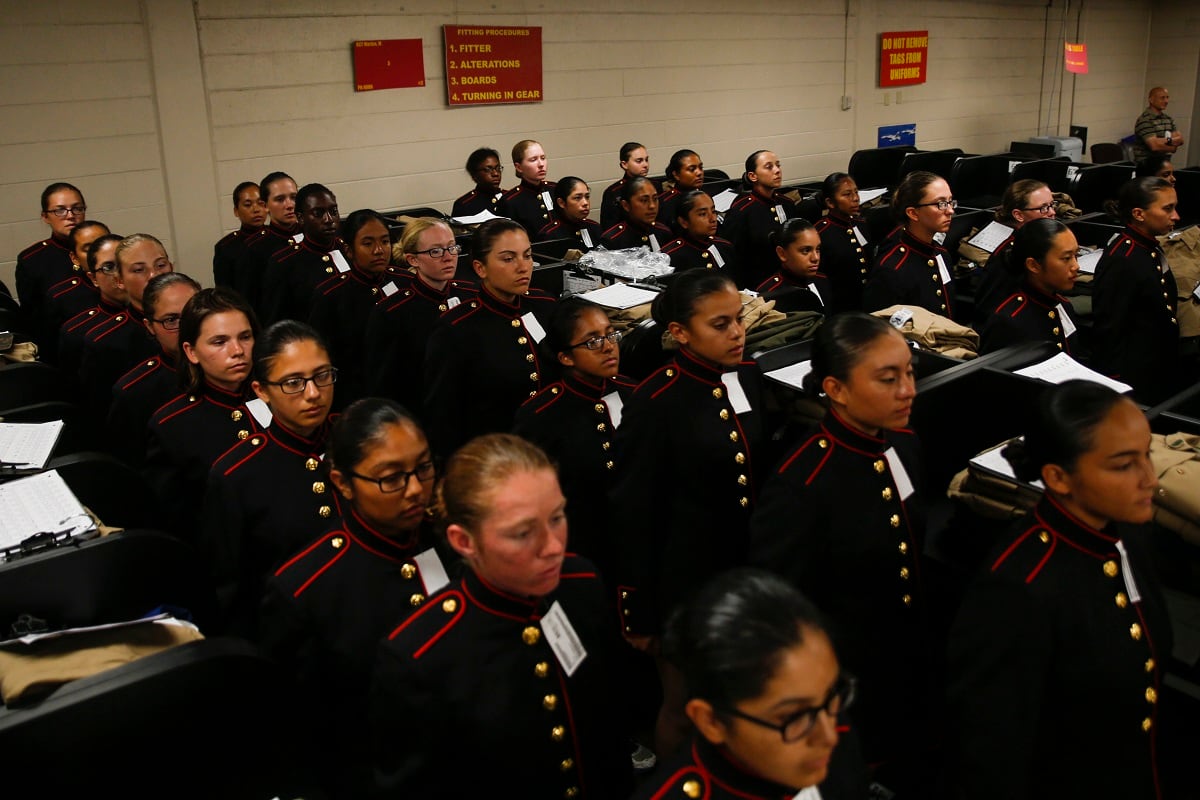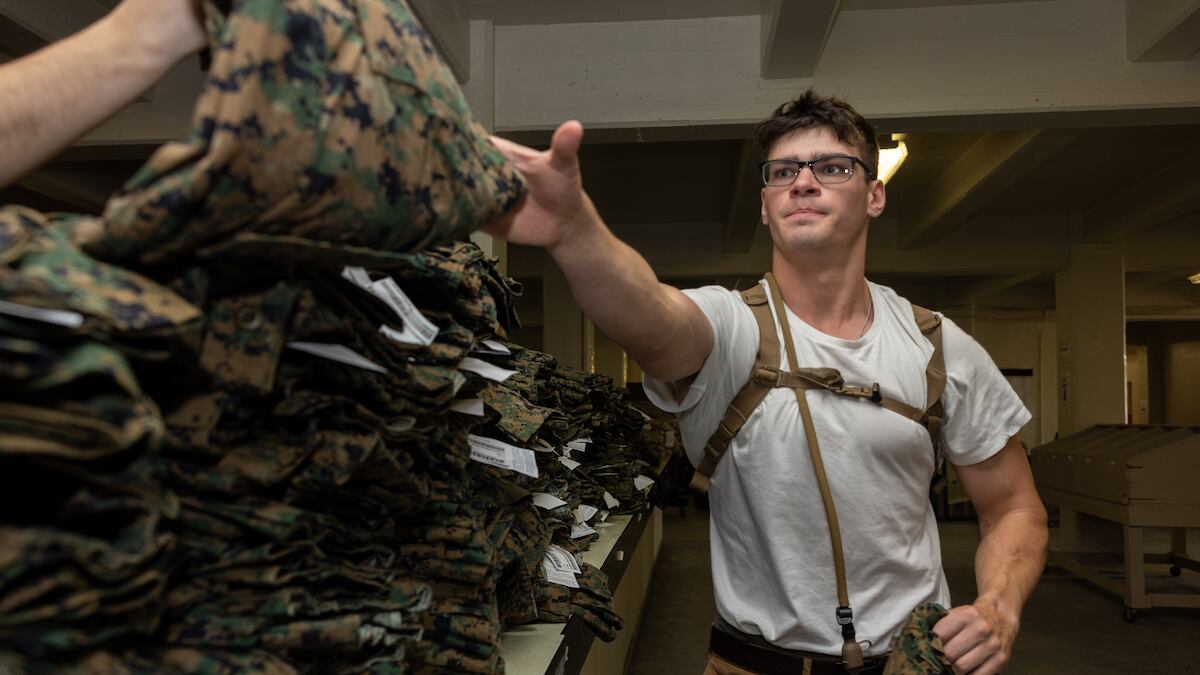After the shoulder ripped on one of Sgt. Ethan Underwood’s camouflage blouses while he was in a martial arts course in September 2022, the Marine sergeant went looking for a replacement.
He tried the Marine Corps Exchange ― the “one-stop shopping destination” for Marines ― at his base in Yuma, Arizona: No luck. He tried the My Navy Exchange website: No luck. He tried the thrift stores near the Arizona base: No luck.
Underwood finally lucked out while home in Texas, at a thrift store near Naval Air Station Joint Reserve Base Fort Worth.
“I managed to find one singular blouse,” said the size-medium sergeant.
RELATED

Marines’ camouflage uniforms are supposed to be difficult for enemy eyes to find. But these days, they’re difficult for even Marines to find.
A scarcity of camouflage combat utility uniforms has prompted some Marines to purchase uniform items on the booming resale market or get creative with tailoring, while recruits train in uniforms usually reserved for deployments.
An end to the shortage is far off: The Marine Corps anticipates the combat utility uniforms won’t be fully back in stock until nearly a year from now.
The CEO of the primary manufacturer of the Marine combat utility uniforms told Marine Corps Times the reason for the shortage is a tight labor market, exacerbated by higher-than-expected inflation.
“I do see better times ahead,” said Chuck Lambert, CEO of American Apparel Inc. “But we’re still in a pretty tough time, struggling, especially now with inflation.”
Recruits in FROGs?
After enlisting or seeking a commission, Marines-to-be receive an initial set of uniforms, which is supposed to include three utility uniforms in the woodland color and two in the desert color, according to Marine Corps guidance from October 2022.
Now, recruits are receiving two woodland and one desert uniform, Marine spokesman Maj. John Parry said via email Monday.
One objective of recruit training is to teach recruits how to “properly wear and maintain uniforms,” according to the official guidance governing the training, which also states the daily uniform for recruits is the combat utility uniform.
But at the Marine recruit depots and schools of infantry, recruits and new Marines have been training in the flame-resistant organizational gear, often known as FROGs, even though Marine Systems Command guidance from 2019 states that the FROGs are “designated for deployment issue only.”

These recruits and Marines have been wearing FROGs “to minimize expected wear and tear from field and combat training,” Parry said.
Entry-level Marines now receive notes in their service record books to document that the Corps owes them an additional set of woodland and desert cammies each, according to Parry.
“Marines may use this entry to obtain a NAVMC 604 form from their chain of command, which can be used at the Marine Corps Exchange to obtain the two additional sets required to complete their standard issue,” Parry said.
The Marine Corps first noticed the shortage of combat utility uniform items in summer 2022, according to Parry.
The spokesman said he expects the shortage, which he attributed to “supply chain issues,” to be resolved by July 2024, “barring any additional delays.”
On the My Navy Exchange website, neither the woodland nor the desert Marine pattern camouflage blouse was available for purchase as of time of publication.
“Unfortunately, we are experiencing supply delays on this item,” the website reads. “The estimated back in stock date is Fall 2024. We greatly apologize for this inconvenience.”
Marine Corps Times attempted to reach the Exchange for comment through a form on the store’s website but did not receive a response by time of publication.
The Marine Corps also is facing shortages of khaki shirts, service coats, dress blue coats and running suits, according to Parry.
Marines can expect the shortages of male dress blue coats to be resolved by October, female service coats by November, khaki shirts and male service coats by January 2024, female dress blue coats by February 2024 and running suits by April 2024, the spokesman said.
“If Marines are affected by a uniform shortfall issue of any type, they should notify their chain of command to resolve the matter,” Parry said.
Constrained by contracts
The combat utility uniforms, often known as cammies, are the everyday outfit for most Marines in garrison and in the field.
As Marine uniforms go, cammies are on the casual side: In warmer months, Marines even wear the sleeves rolled up to their biceps. On Fridays, and when interacting with the public, Marines usually wear the dressier service uniform.
The Marine Corps has used its distinctive camouflage pattern, composed of clumps of pixels, since 2002.
RELATED

In 2018, the Alabama-based American Apparel Inc. — a longtime Marine uniform manufacturer — received from the Defense Logistics Agency a one-year contract, with four one-year option periods, to make more Marine Corps combat utility uniforms. The firm-fixed-price contract was worth a maximum of more than $71 million.
That locked American Apparel Inc. into producing the uniforms at that set price for five years, even as the economic challenges of those years pushed up costs, according to Lambert, the CEO.
“Nobody even knew the word ‘COVID,’” Lambert said of the time the contract was awarded to American Apparel Inc.
American Apparel Inc. is unrelated to the international retail clothing company of the same name.
Lambert said it was hard to get people to come into work during the coronavirus pandemic because they could make more money from stimulus checks. Fears of contracting the virus, limited access to child care and a wave of retirements also limited the nation’s labor supply, according to Wall Street Journal reporting.
As the pandemic subsided, high inflation drove up the wages workers expected, and many decided to eschew in-person work altogether. But the company couldn’t afford the wage increases necessary to attract workers back to factories, according to Lambert.
“McDonald’s and a lot of the fast food guys are paying $2 and $3 more an hour than we could afford to pay,” the CEO said. “Where they could go up on the price of the hamburger, we can’t go up on the price of a uniform.”
Meanwhile, American Apparel Inc.’s fabric suppliers — like many defense contractors — were facing labor-market pressures of their own, Lambert said. The bump in fabric costs makes it even harder to manufacture uniforms, he noted.
Improvising and adapting
Underwood, the sergeant in Arizona, told Marine Corps Times he has seen Marines patch holes in their cammies with Marine-pattern bandanas or scraps of old uniforms. But most Marines he knows are getting their cammies at thrift stores or on eBay.
In fiscal year 2023, active-duty enlisted Marines with more than three years’ service get $738.84 and those with less than three years’ service get $517.32 to spend on replacing worn-out or lost (or “lost”) uniforms.
The new or used combat utility uniforms available on some websites like eBay sometimes come at hefty prices that, for a junior Marine, could add up quickly.
The resale market has been affected by the restricted supply of cammies, said Dan Rullamas, president of Devil Dog Depot, which sells Marine gear from the civilian market.
About two years ago, Rullamas noticed an increase in the price his suppliers charged for camouflage uniform items. At first, the Marine veteran chalked it up simply to inflation, but about a year ago demand for his products increased, too.
As of Tuesday, one seller on eBay was offering brand-new size-large woodland camouflage pants for $200, plus $10.40 in shipping and $12.62 in tax — approximately one-tenth of a lance corporal’s monthly salary. Four people already had purchased them, according to eBay.
Rullamas said such high markups are “messed up” and his company doesn’t engage in that practice. But he said Devil Dog Depot has had to increase its prices to stay afloat as its suppliers charge 200%–300% more than they did two years ago.
“We’re just trying to fill the void of: Marines need gear, and they need it quick, and the government isn’t always able to do that,” Rullamas said.

In December 2022, the Marine Corps acknowledged shortages affecting the running suit, the combat blouse, the men’s long and short-sleeved khaki shirt and the all-weather coat, Marine Corps Times reported.
In March, the Defense Logistics Agency awarded the Puerto-Rico-based Pentaq Manufacturing Corp. a firm-fixed-price contract worth a maximum of $14.3 million to make more of the uniforms throughout the next five years. American Apparel Inc. in April received a new contract for the same time period, worth a maximum of $71.6 million.
Lambert, the American Apparel Inc. executive, said the California-based AMPO USA also received a contract earlier in 2023. The service-disabled-veteran-owned small business did not respond to a Marine Corps Times request for comment by time of publication.
For now, despite the new contracts, Marines seeking cammies are left to improvise and adapt.
Approximately two months ago, one lieutenant colonel in the Middle East contacted Rullamas to ask him for a uniform, the Marine vet told Marine Corps Times. The lieutenant colonel had no access to uniforms where he was, and he said the Exchanges in the United States were sold out, according to Rullamas.
Rullamas said he got a uniform to the officer within 10 days.
The Marine veteran emphasized he wasn’t blaming the Marine Corps or anyone else for the shortage.
But he said, “Somebody who is leading hundreds, if not a thousand, Marines and has control over tens of millions of dollars of equipment can’t get a uniform.”
Irene Loewenson is a staff reporter for Marine Corps Times. She joined Military Times as an editorial fellow in August 2022. She is a graduate of Williams College, where she was the editor-in-chief of the student newspaper.





